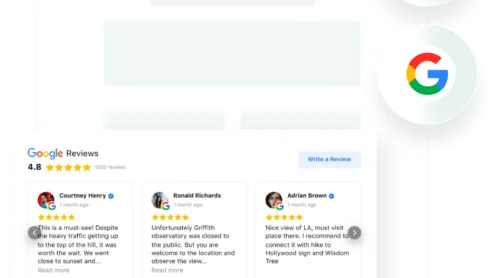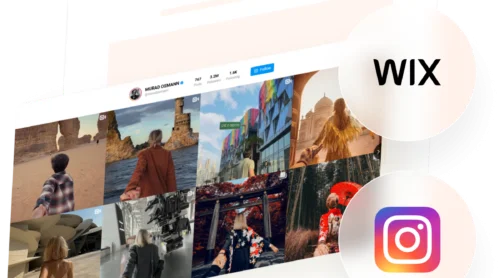You know how it feels when your website looks a little too quiet, or when visitors show up and leave without really connecting with your brand? If you want to keep people interested and coming back, a live LinkedIn Feed can help, bringing company updates and social proof straight to your pages. It’s a way to show what’s new in your business, invite conversation, and give your website that extra spark of relevance.
That’s where the LinkedIn Feed widget comes in, letting you embed company posts, images, and videos directly on your website. It updates automatically, so you never have to refresh things by hand. You get a professional look that matches your brand, and your visitors see the latest news and stories without ever leaving your website. For businesses and creators who want a simple, reliable way to connect their website and LinkedIn – this practical no-code solution saves time and keeps engagement high.
- Easy, step-by-step setup. We’ll walk through the installation process from start to finish.
- Native Alternatives. Explore other ways for LinkedIn Feed intergation.
- Ultimate user checklist. Tick all the boxes for the best widget experience.
- Quick troubleshooting tips. Solve common hiccups so your feed goes live without a hitch.
To make things as straightforward as possible, we’ve split the guide into basic setup steps and a detailed description with tips, so you know exactly how to integrate LinkedIn into your website on your own.
Setup Preview: How it Works
Here’s a quick guide for anyone who wants to add LinkedIn posts to their website right away.
- Open Elfsight’s editor and pick a template.
- Customize your LinkedIn Feed widget.
- Click ‘Add to website for free’ and copy the code.
- Paste it into your website’s backend.
Connect & customize your LinkedIn Feed in the free editor!
Unlocking LinkedIn Feed Capabilities
You’ve seen how quick and easy it is to display a LinkedIn Feed on your website. Let’s dive into the key features that make it so effective:
| Key Feature | Why it Matters |
|---|---|
| Displays Real-Time Content | Keeps your website updated with the latest LinkedIn posts, including images and videos, ensuring visitors always see fresh content. |
| Customizable Layouts and Styles | Allows you to match the feed’s appearance to your website, enhancing visual appeal and brand consistency. |
| Pop-up Post Views | Provides an interactive way for visitors to explore posts in detail without leaving your website. |
| Seamless Integration | Works smoothly across all major CMS and website builders without need for coding skills as well as across various devices. |
| Instant Embed Code Generation | Enables quick installation through an intuitive editor, making it easy to customize and add the feed to your website with a simple copy-paste snippet. |
These are just a few of the many benefits the LinkedIn Feed Widget offers. For the full list, check out the widget’s Features Page. With these powerful capabilities in mind, we can now move on to integrating the LinkedIn Feed into your website step by step.
Full Tutorial: From Template to Embed
The steps below follow our recommended installation workflow for best performance, including some practical tips:
1. Choose a Template
You start by opening the widget editor and picking a template. Templates set the base look of your LinkedIn feed – from a minimal professional List to a bold Carousel or Slider. Try a few to see which one fits your website layout and business tone.
Click “Continue with this template” once you have a base you like.
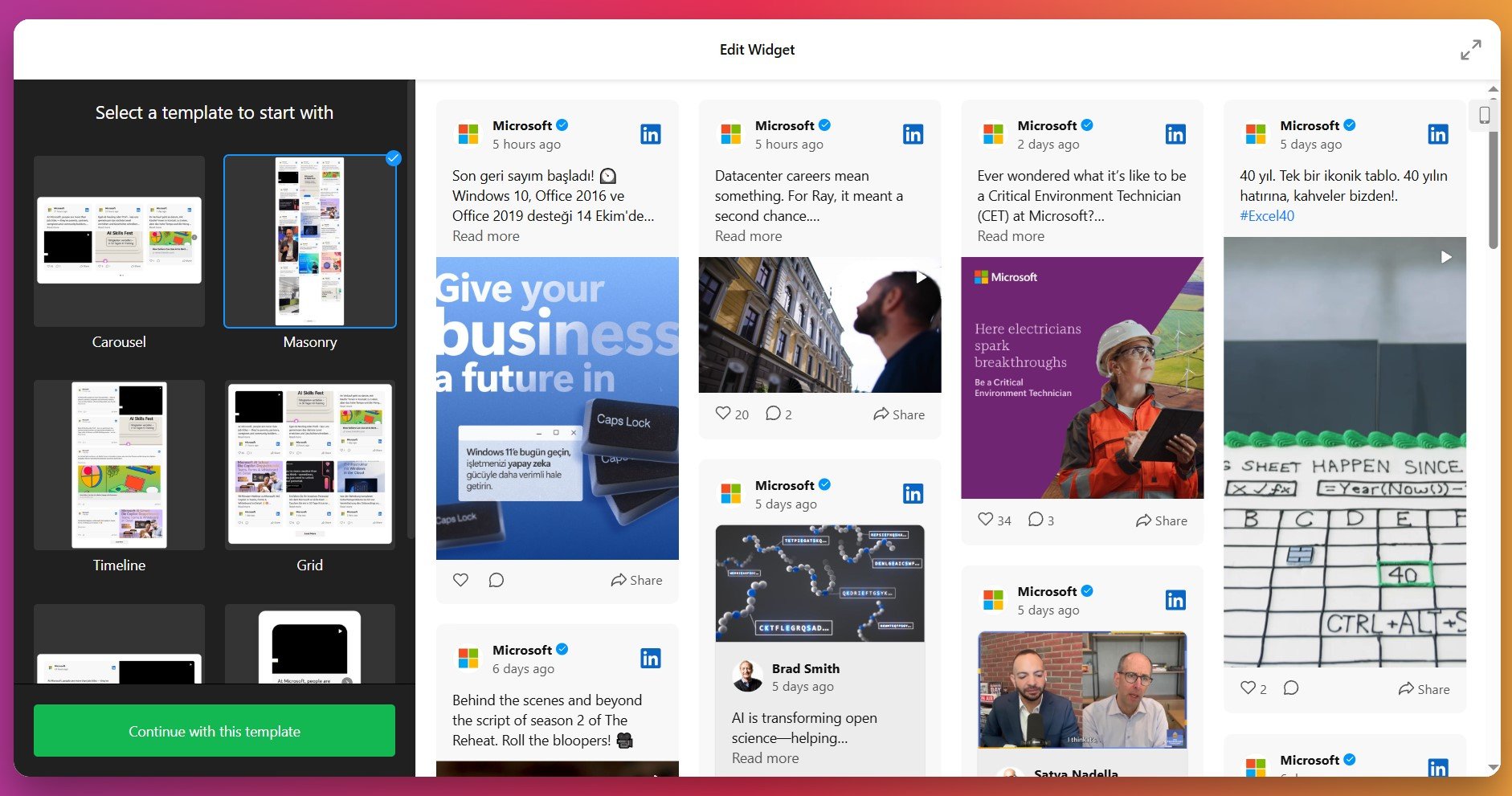
2. Add the Content Source
The next step is to tell the widget where to pull content from: paste the URL of your LinkedIn company page or personal profile to fetch published posts automatically. The editor will process the page and load existing posts (text, images, videos, attachments).
Use the feed controls to preview the posts and confirm they’re populating correctly.
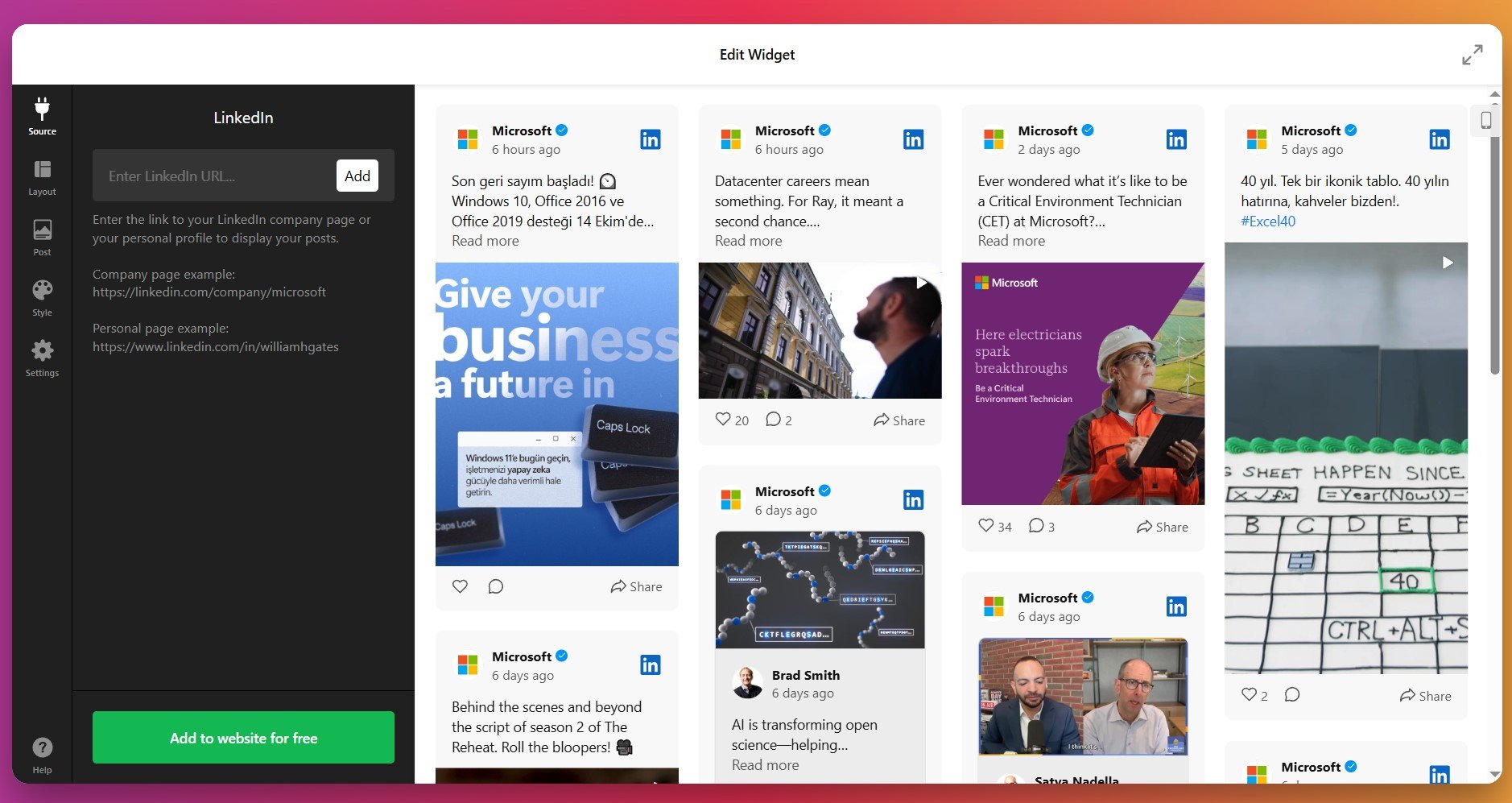
3. Configure the Layout
At this stage, you decide how your posts will be arranged. The Layout tab offers multiple display modes so you can match the widget to the page area and design hierarchy.
- Grid: Classic, symmetrical layout for multiple posts.
- Masonry: Responsive, variable-height tiles for mixed media posts.
- List: A vertical feed ideal for blog or news-style pages.
- Carousel: Rounded, compact carousel for a hero or sidebar slot.
- Slider: Compact rotating feed with navigation controls and autoplay options.
You can also adjust rows/columns, post width, spacing, set mobile vs desktop behavior, and pick the visible number of items before users have to click “Load more”, unless you opt for infinite loading.
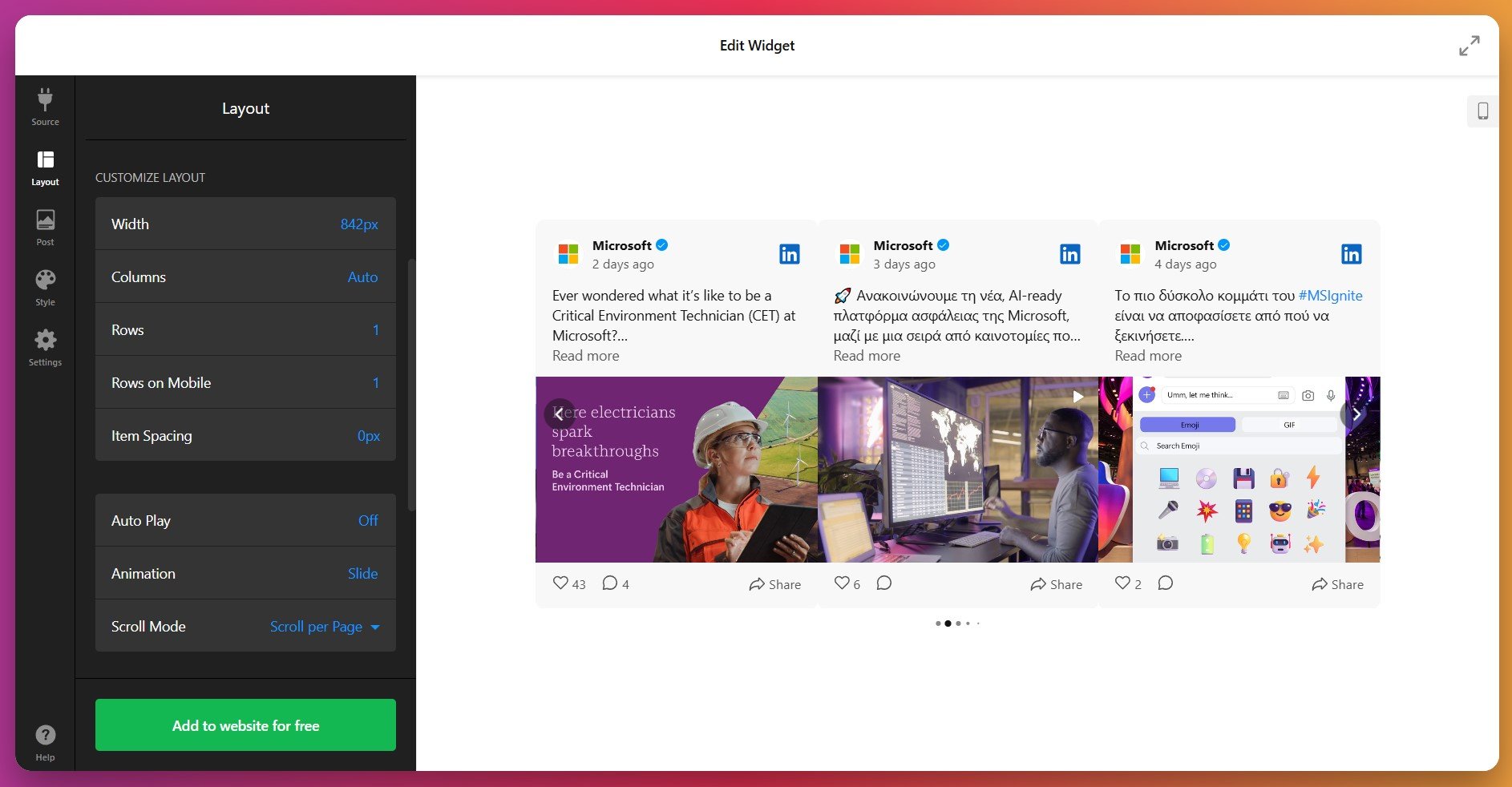
4. Customize Post Display
In the Post tab, you control each post card: there are multiple card styles and you can toggle which elements appear (author avatar, author name, post text, date, action bar, source badge, attachments).
Choose what happens on click: open in a popup, open the original post on LinkedIn, or do nothing (static). This lets you either keep visitors on your website or drive them to LinkedIn for engagement.
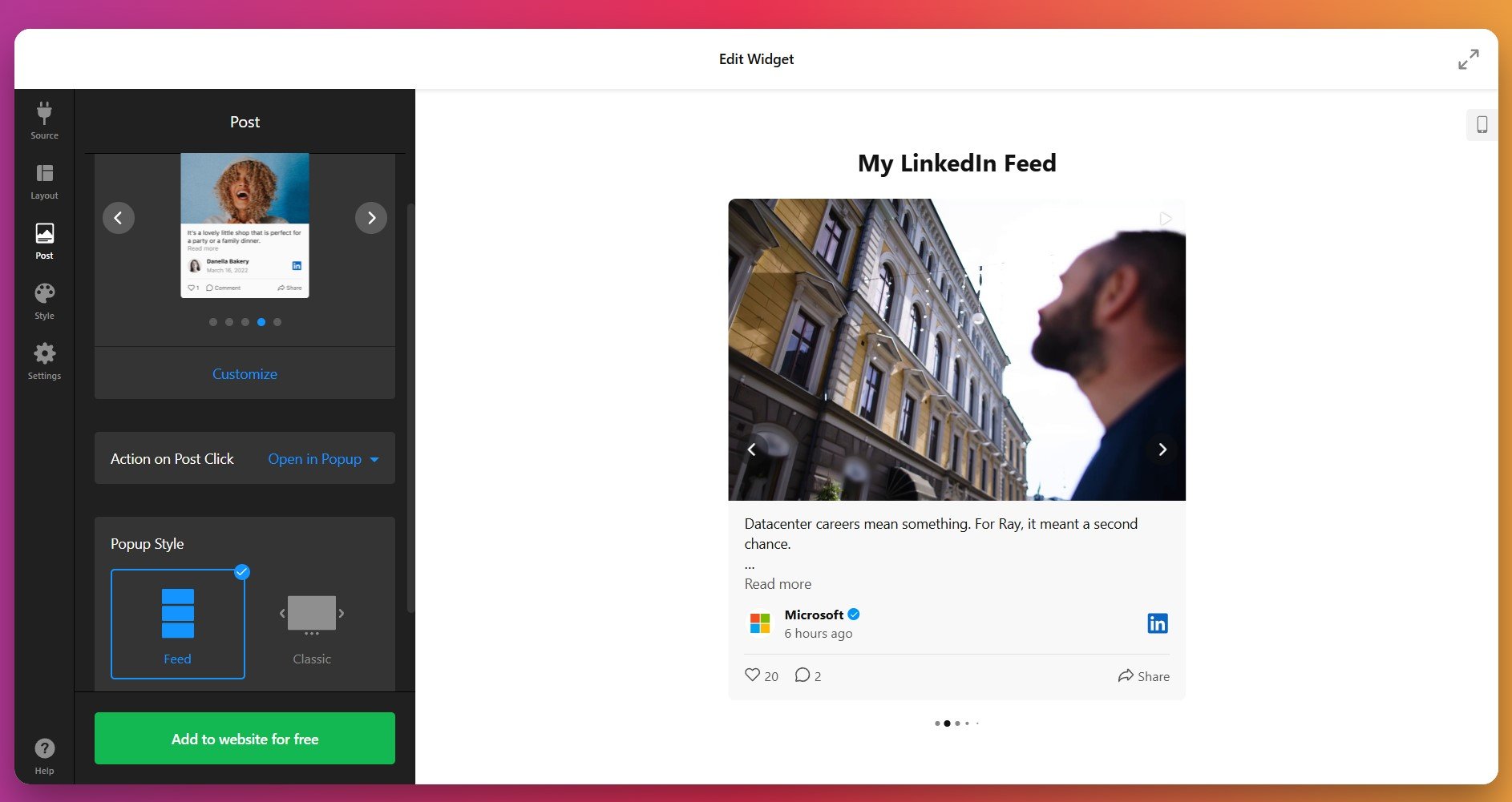
5. Adjust the Appearance
Under the Style tab you can customize and match the feed to your brand:
- Color Scheme: Choose the Light, Dark or Custom themes.
- Fonts: Pick the primary font for your feed from our library.
- Header and Post: Adjust alignment, colors of elements and text parameters.
- Navigation: Set the size and color of arrows in default state and on hover.
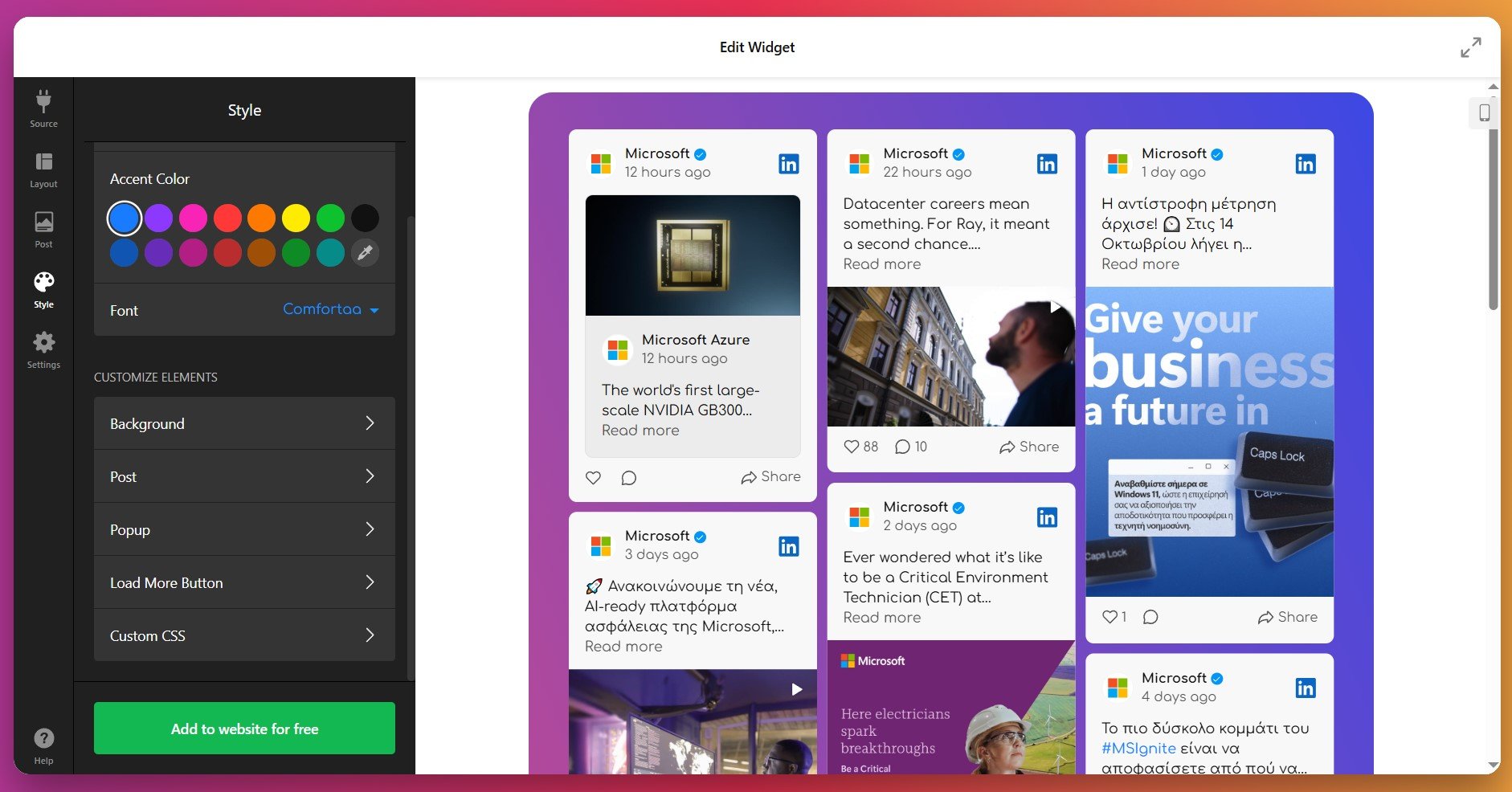
If you need exact brand compliance, the widget includes a Custom CSS editor for advanced styling. Want to try it but unfamiliar with coding? In the editor, you’ll find links to our Feature Request form and Forum discussions for ready-to-use CSS from other users.
6. Configure the Settings
As the last step, you modify widget behavior and global settings in the Settings tab: set localization (20+ languages), text labels, and add custom JS code if needed.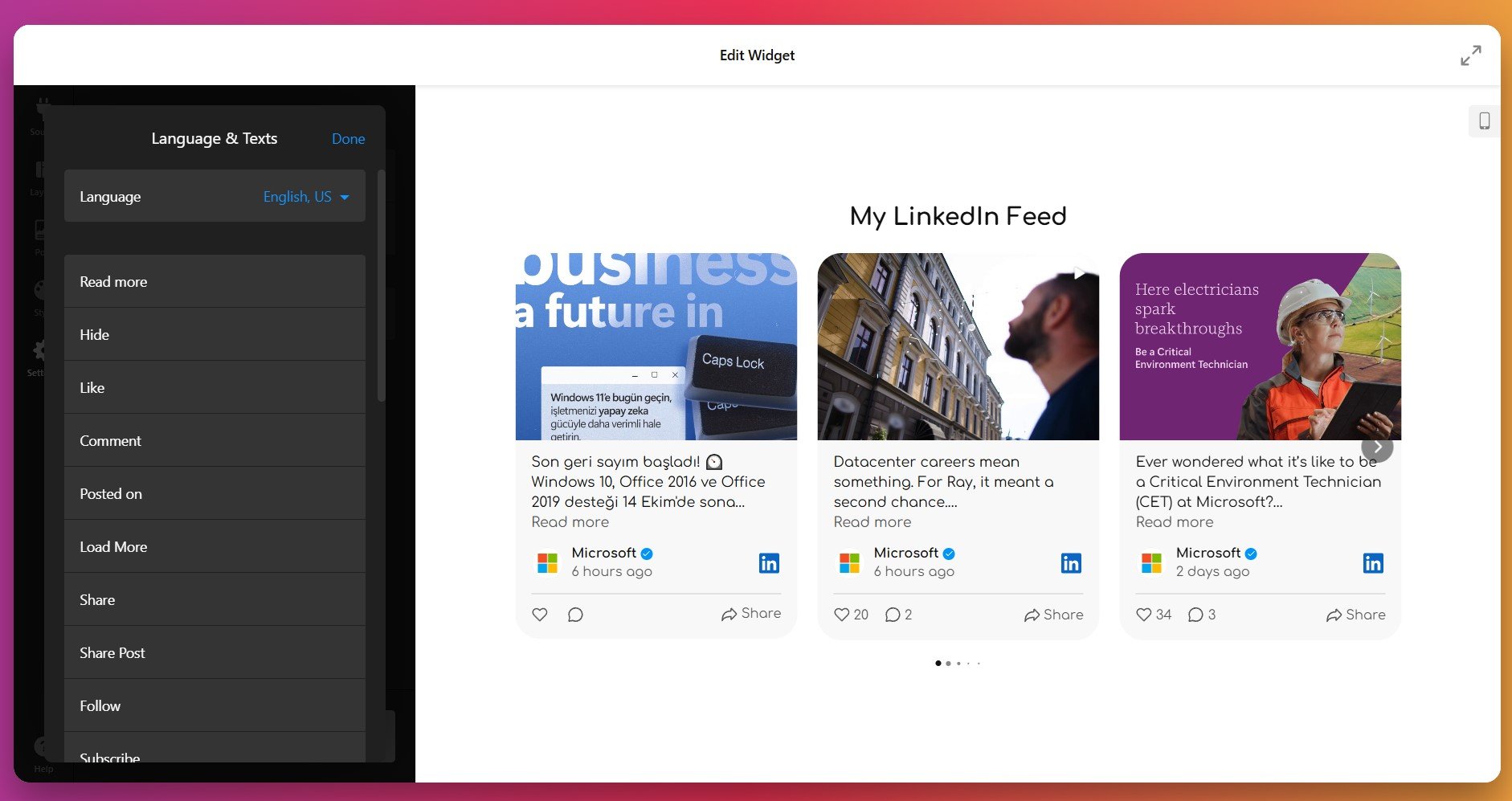
7. Get the Installation Code
When the widget is ready, click “Add to website”. The editor will generate your personal embed code — copy it to your clipboard. This snippet contains all the widget settings you configured.
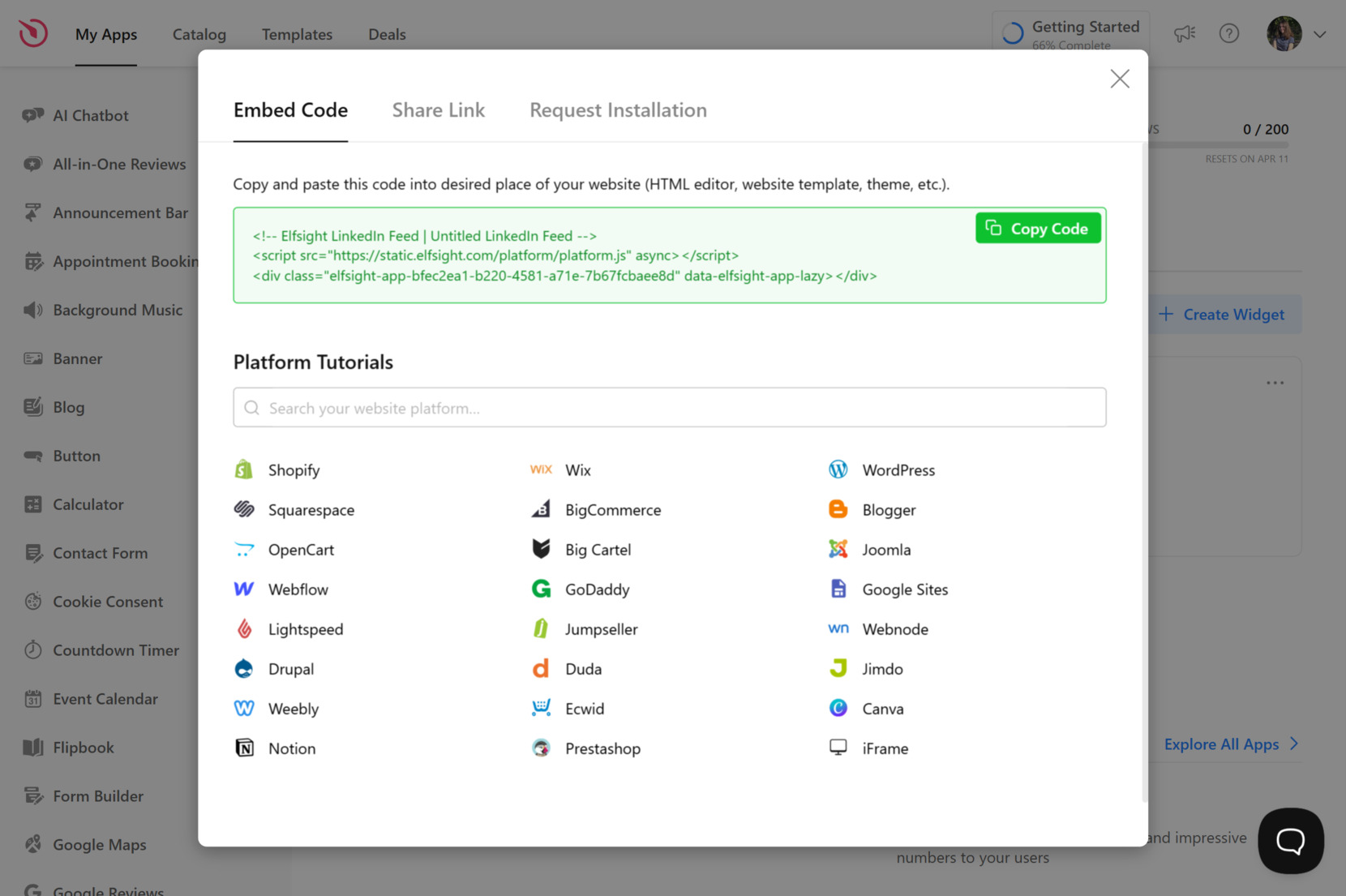
8. Embed LinkedIn Feed on Website
With your widget fully configured and Elfsight snippet copied, the only thing left to do is to choose where the widget should appear on your website. Below are three common methods — they work the same way for LinkedIn as for other Elfsight social widgets.
Option 1: Specific page
Quick workflow: Open page Editor → Insert HTML block → Paste code → Save & Publish
- Open your website Editor for the chosen page
- Insert an “HTML” or “Embed” block (or “Custom HTML” widget)
- Paste the Elfsight snippet into the chosen block
- Save to apply changes
- Resize the block as needed and preview in mobile view
Option 2: Inline widget on all pages
Quick workflow: Open website Editor → Paste code into HTML field → Save & Publish
- Open your website Editor
- Navigate to a site-wide HTML/Embed area (e.g., theme footer, global section, or a block that shows on every page)
- Paste the Elfsight snippet into the HTML field
- Save to apply changes
- Refresh to preview – the LinkedIn feed will display wherever that block appears
Option 3: Floating widget (specific or all pages)
For a floating placement (e.g., a corner feed or a persistent widget), add the snippet via your CMS/global custom code settings:
Dashboard → Settings → Custom Code → Body – Start
Choose page targeting if your platform allows (specific pages vs. all pages).
In case you want to explore other options, we’ve got you covered: the next sections covers other reliable methods to embed LinkedIn company feed on website.
Alternative Ways to Show LinkedIn Feed
There are a few alternative methods for adding LinkedIn content to your website, though each comes with some notable trade-offs compared to a custom all-in-one solution.
Manual Embed via LinkedIn’s Native Option
LinkedIn allows you to embed individual posts directly from the platform using a built-in feature.
- Navigate to your company page. Go to the posts section and locate the content you want to display.
- Access the embed option. Click the three dots in the upper right corner of a post and select “Embed this post.”
- Copy the generated code. Click the “Copy code” button in the popup window.
- Paste into your website. Add the code to your page editor where you want the post to appear.
- Repeat for additional posts. Each post requires manual embedding, repeating the process for every piece of content.
This method requires manually repeating the entire process every time you want to add a new post.
More details are available in LinkedIn’s documentation.
WordPress Plugin Integration
WordPress users can install dedicated plugins from the official repository.
- Install a LinkedIn plugin. Download and activate a compatible plugin from the WordPress plugin repository.
- Create an account. Sign up for the plugin service, which typically offers a limited free trial period.
- Connect your LinkedIn page. Add your company or personal LinkedIn page URL through the plugin dashboard.
- Configure display settings. Customize how posts appear using the plugin’s options panel.
- Embed using shortcode. Copy the provided shortcode or PHP code and insert it into your WordPress pages.
This solution works exclusively on WordPress websites and cannot be used on other platforms.
More information can be found in WordPress plugin directories.
Third-Party Content Aggregation Services
Various social media aggregation platforms offer LinkedIn feed collection capabilities through their dashboards.
- Sign up for an aggregation service. Create an account with a content collection platform that supports LinkedIn.
- Add your LinkedIn source. Input your company page URL or configure hashtag and keyword tracking.
- Customize the widget design. Adjust layout, colors, and display options through the service dashboard.
- Copy the embed code. Retrieve the JavaScript or iframe code generated by the platform.
- Add code to your website. Paste the embed code into your website builder or content management system.
Collecting content from company pages requires you to have admin permissions on those LinkedIn pages.
Additional setup guidance is typically provided in platform documentation. Look for Support or Help Center pages.
How Do These Methods Compare?
| Method | Major Pro 👍 | Major Con 👎 |
|---|---|---|
| Elfsight | Automatic updates, works on any website platform, and requires no technical skills or special permissions. | Use of a third-party widget is required. |
| Manual Embed via LinkedIn | No third-party service needed, making it a straightforward option for single posts. | Each post must be added individually with no automatic updates, creating significant maintenance overhead. |
| WordPress Plugin Integration | Designed specifically for WordPress users with familiar dashboard controls. | Limited to WordPress only and often requires premium subscriptions for essential features like auto-sync. |
| Third-Party Content Aggregation | Can collect content from multiple social platforms in one place. | Requires admin access to company pages and typically offers limited free features. |
If you want practical guidance for making your LinkedIn feed display effectively and maintain consistent performance on your website, keep reading for expert implementation tips.
📝 Pro Tips for Adding LinkedIn Feed to Any Website
- Boost Trust with Author Info Enabled. Users are more likely to engage with real people than brands. If you use personal branding alongside company updates, turn on author photos and names – this humanizes your feed instantly.
- Make Posts Clickable Many people don’t realize you can turn off popups and link posts directly to LinkedIn. This is ideal when your goal is driving profile traffic, connections, or lead outreach.
- Ensure Mobile Responsiveness. Test the widget on mobile devices to ensure all content is visible and accessible, as many users will view it on their phones.
- Optimize Loading Speed. Limit initial load to 6–9 posts and enable “Load More”. This improves Core Web Vitals and prevents layout shift.
- Improve Layout Balance. In Post → Customize, adjust Image Ratio (original, 1:1 square, 2:3 vertical, etc.) to fit your exact website layout and requirements.
- Check LinkedIn Updates. If image previews break or captions disappear, it often isn’t a bug — LinkedIn just changed their HTML structure. Reconnect your LinkedIn source to refresh permissions.
- Use Post Filtering. If your company posts a lot of jobs, they can overwhelm the feed. Use keyword-based filters (e.g. “hiring,” “remote,” “apply”) in the moderation settings to hide recruiting posts and keep the feed focused on content that builds trust.
Some questions come up repeatedly around setup, content syncing, and display options for LinkedIn Feed. Below is a tested FAQ section to help you troubleshoot and get the most out of your widget.
LinkedIn Feed Widget Issues & Fixes
Unlike some other social platforms, LinkedIn has specific limitations when it comes to embedding content. The most significant barrier is that LinkedIn doesn’t support traditional embedded widget codes in the same way platforms like Facebook or Instagram do. Understanding these limitations upfront saves frustration during setup.
My LinkedIn Feed widget isn't showing any posts after setup. What's wrong?
Can I embed individual LinkedIn posts instead of a full feed?
The widget feed isn't updating with my newest LinkedIn posts. How do I fix this?
Deleted post still displayed in my LinkedIn Feed widget. Any way to get rid of it?
What's the difference between embedding a company page feed versus a personal profile feed?
If these solutions don’t resolve your specific situation, you’ll find additional guidance and direct support through the official Elfsight help resources.
Need More Details?
We hope this guide gives you a solid foundation to add a LinkedIn Feed to your website and connect with your audience in new ways. We care about making things easier for you and always welcome your questions or feedback. Share your experiences and connect with the Elfsight team on LinkedIn, Facebook, or X to stay updated and join the conversation.



